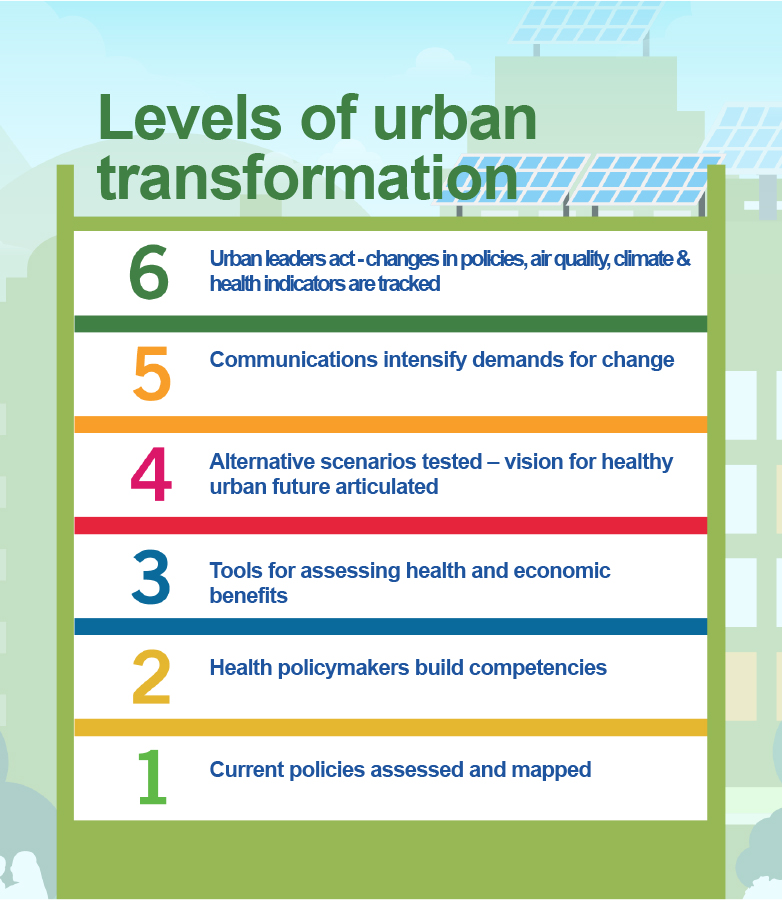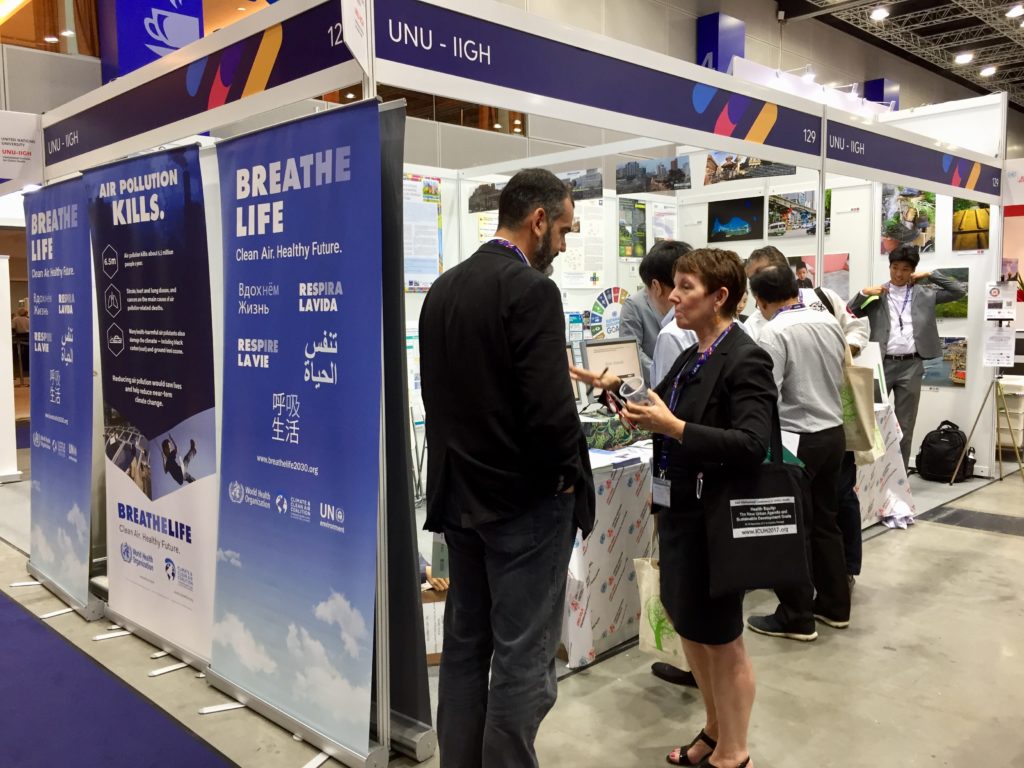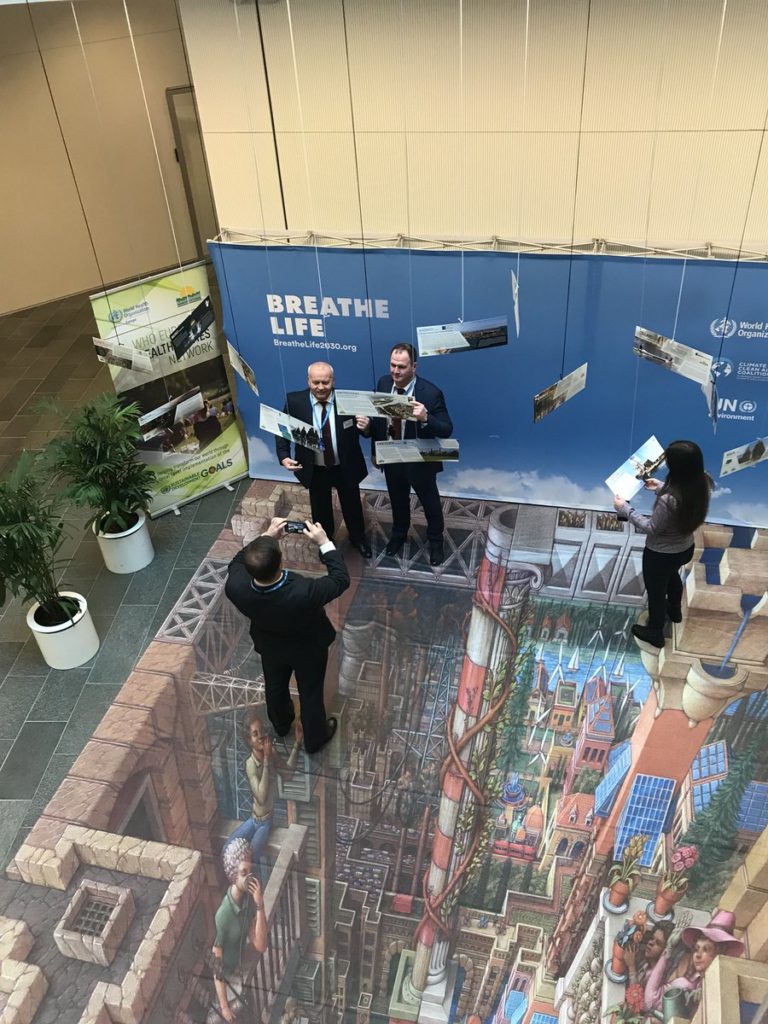The nitty-gritty of ensuring that health is adequately considered in the building of sustainable, pollution-free cities was a hot topic at the 9th World Urban Forum.
A highly popular training event led by a World Health Organization (WHO) team attracted a full roster of participants interested in learning about tools and methods to quantify the public health impacts of policies and build momentum and support for public and private action.
Consultant and former Coordinator of Interventions for Healthy Environment at the WHO, Carlos Dora, set the scene, introducing participants to the efforts of the Urban Health Initiative, which is working with pilot countries to quantify the health costs and savings of current and potential policy choices in all spheres, with a particular focus on air pollution.

Carlos Dora, Pierpaolo Mudu and Thiago Henrick Da Sa of the WHO; Nandita Murukutla of Vital Strategies, a CCAC partner; Martina Otto of UN Environment; and Kevin Austin of C40 cities
“If we use the values of a statistical life, we get numbers that are very big, but we don’t know who is paying the costs of pollution and who is getting the savings; economic analysis allows us to document this and the savings that can be gained from specific actions that reduce air pollution,” he said.

The Urban Health Initiative’s theory of change
This, he said, can help increase accountability for policy actions in both the public and private sectors.
WHO scientist Pierpaolo Mudu led a well-received interactive session that gave participants a taste of the use of tool AirQ+, software that quantifies the health effects of exposure to air pollution, including estimates of reductions in life expectancy.
He emphasized the accessibility of the software and the importance to the policy process of determining and quantifying the long- and short-term impacts of air pollution.
Thiago Herick de Sa, WHO Urban Health and Sustainable Mobility expert, engaged the audience in an interactive session on sustainable urban transport and its impacts on health, including potential savings accrued from action to improve air quality as well as the health costs of inaction.
He steered the discussion towards the challenges and available tools for taking into consideration the full range of health benefits of sustainable mobility, such as potential improvements in traffic safety and increased physical activity.
Sustainable transport is relevant to both air pollution and many other targets in the 2030 Sustainable Development Goals, and WHO is working on tools that can help policymakers generate important information to this end.
This importance of working across sectors and traditional silos was also emphasised by UN Environment‘s Head of Cities Unit Martina Otto in her presentation on sustainable lifestyles: “integration, integration, integration… across levels of governments, across different topics and policy areas.”
Executive Director of C40 Cities Kevin Austin also raised the importance of harnessing the strengths of the private sector in his talk on improving air quality and health through action in transport.
“Cities need to work with the private sector to harness the innovation required to meet pollution and climate goals,” he said, taking the audience through the case of London, which had worked with the private sector to drive the cost parity of cleaner buses.
Austin also introduced audiences to the Fossil Fuel Free Streets Declaration, through which city governments pledge to take action towards transitioning to Fossil-Fuel-Free Streets by procuring only zero-emission buses from 2025 onwards and ensuring a major area of their respective cities are zero-emission by 2030.
VP, Global Policy and Research at Vital Strategies Nandita Murukutla presented on the importance of strategic communications to the success of campaigns and social change, giving participants a tool to guide communications planning alongside campaign planning.
“Communications is essential to creating supportive attitudes for policy change and to keeping up the momentum for change,” she said.
Communications is also a crucial part of the Urban Health Initiative’s theory of change that would drive urban leaders to act and include air pollution and health impacts and indicators in the policy process.
She also introduced the BreatheLife campaign that unites cities, regions and, increasingly, interested countries, towards the goal of halving deaths from air pollution by 2030, while reaping climate and public health co-benefits. It is led by WHO, the Climate and Clean Air Coalition (CCAC) and UN Environment.
“The response from cities took us by surprise. Through BreatheLife, we started to show that there are sources, culprits and things that can be done,” said Carlos Dora.
The World Health Organization was on the ground at the World Urban Forum, leading and engaging in the discussion at the crossroads between urban development and public health. Its home at the WUF was the UNU-IIGH booth, where a full programme of talks on global urban health took place throughout the event.

The UNU-IIGH booth was the centre of urban health events and discussions at the WUF
Taking place in Kuala Lumpur, the conference attracted 20,000 delegates focused on all dimensions of developing sustainable, resilient and liveable urban areas and the pursuit of the 2030 Sustainable Development Goals.
In parallel, in Copenhagen, the BreatheLife campaign was making an impression on delegates at the WHO European Healthy Cities Summit of Mayors, many of whom stopped by the BreatheLife exhibit of success stories for an overview of the issues at hand.

Delegates and urban leaders at the European Healthy Cities Summit of Mayors stopped by the BreatheLife exhibit for perspectives and solutions on urban health and environment issues
“The WHO European Network has the potential to act as a means through which to implement the Breathelife campaign in Europe, the Age Friendly cities Network, and other initiatives,” said Regional Director WHO European Regional Office Zsuzsanna Jakab at the closing session of the event, which brought together urban leaders from across Europe and yielded approval of a new Copenhagen Consensus Covenant of Mayors, on healthier more liveable cities.